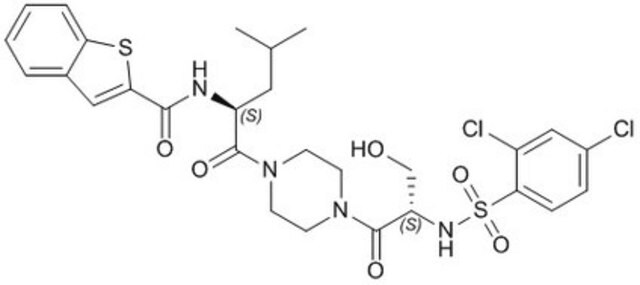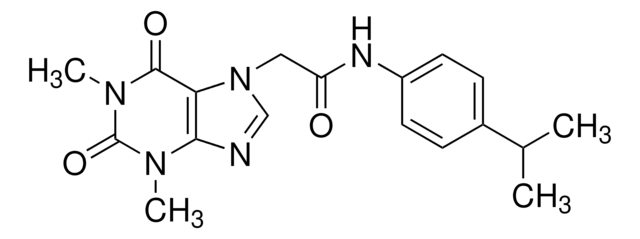SML0942
GSK2193874
≥98% (HPLC)
Synonym(s):
3-([1,4′-Bipiperidin]-1′-ylmethyl)-7-bromo-N-(1-phenylcyclopropyl)-2-[3-(trifluoromethyl)phenyl]-4-quinolinecarboxamide
About This Item
Recommended Products
Quality Level
assay
≥98% (HPLC)
form
powder
color
white to beige
solubility
DMSO: >5 mg/mL, clear
storage temp.
room temp
SMILES string
FC(F)(F)c1cc(ccc1)c2nc3c(c(c2CN6CCC(CC6)N7CCCCC7)C(=O)NC5(CC5)c4ccccc4)ccc(c3)Br
InChI
1S/C37H38BrF3N4O/c38-28-12-13-30-32(23-28)42-34(25-8-7-11-27(22-25)37(39,40)41)31(24-44-20-14-29(15-21-44)45-18-5-2-6-19-45)33(30)35(46)43-36(16-17-36)26-9-3-1-4-10-26/h1,3-4,7-13,22-23,29H,2,5-6,14-21,24H2,(H,43,46)
InChI key
UIVOZBSCHXCGPS-UHFFFAOYSA-N
Application
- to study its effects on GSK101-induced colon contractions in mice[1]
- to study its effects on murine compact bone-derived osteoblasts(CB-OB)[2]
- to study its effects on lung injury post-lipopolysaccharide (LPS) in mice[3]
Biochem/physiol Actions
signalword
Danger
hcodes
Hazard Classifications
Acute Tox. 3 Oral - Eye Irrit. 2 - Skin Irrit. 2 - STOT SE 3
target_organs
Respiratory system
Storage Class
6.1C - Combustible acute toxic Cat.3 / toxic compounds or compounds which causing chronic effects
wgk_germany
WGK 3
flash_point_f
Not applicable
flash_point_c
Not applicable
Choose from one of the most recent versions:
Certificates of Analysis (COA)
Don't see the Right Version?
If you require a particular version, you can look up a specific certificate by the Lot or Batch number.
Already Own This Product?
Find documentation for the products that you have recently purchased in the Document Library.
Customers Also Viewed
Our team of scientists has experience in all areas of research including Life Science, Material Science, Chemical Synthesis, Chromatography, Analytical and many others.
Contact Technical Service














